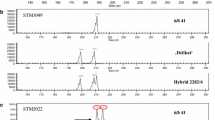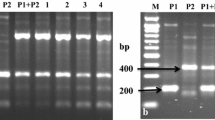Abstract
Mexican wild diploid species,Solanum pinnatisectum (S. pnt) (2n=2x=24, 1EBN: endosperm balance number) is a useful germplasm source of late blight and Colorado potato beetle (CPB) resistance in potato improvement. However, it is very difficult to cross this species with other 1EBNSolanum species. Sexual hybrids among three accessions ofS. pnt and two accessions ofS. cardiophyllum (S. cph) (2n=2x=24, 1EBN) were studied. There were large differences in the cross-compatibility among the genotypes and accessions from these two 2x-1EBN species. Interspecific incompatibility existed in the crosses betweenS. pnt andS. cph, in whichS. cph functioned only as the male parent. The crosses with accessions PI 275236 ofS. pnt produced 35 hybrids following the conventional propagation procedures. Seven hybrids were obtained with theS. pnt accession PI 275233 with the aid of embryo rescue, while hybridization involving accession PI 253214 resulted in no fruit. The cytogenetic analysis indicated that all of the hybrids derived from crosses of accession PI 275233 ofS. pnt withS. cph had 2n = 24 chromosomes and were pollen fertile. Crosses involving accession PI 275236 ofS. pnt produced both 2x (2n=24) and 3x (2n=36) hybrids. Meiotic analysis at metaphase I of pollen mother cells (PMCs) showed a fairly high rate of chromosome pairing that averaged between 10.10 and 11.10 bivalents per cell in most of the 2x hybrids, indicatingS. pnt andS. cph have the similar genome. A high frequency of trivalents and quadrivalents were observed in 3x hybrids derived fromS. pnt 2 ×S. cph 1, indicating homology exists among these chromosomes. These results suggest that specific gene(s) and not either differences between genomes or EBN controlled interspecific crossability and embryo development. The disease and insect tests on the 2x and 3x hybrids revealed that all have high levels of resistance to both late blight and CPB. Thus it could appear that selection of genotypes is a key for successful interspecific hybridization when using Mexican wild diploid species as a source of economic important traits.
Resumen
La especie silvestre diploide mexicana,Solanum pinnatisectum (S. pnt) (2n=2x=24, 1EBN: número de balance del endospermo) es una fuente útil de germoplasma para resistencia al tizón tardío y al escarabajo (Colorado potato beetle: CPB) para el mejoramiento de la papa. Sin embargo, es muy difícil cruzar esta especie con otras especies deSolanum. Se estudiaron los híbridos sexuales entre tres accesiones deS. pnt y dos accesiones deS. cardiophyllum (S.cph) (2n=2x=24, 1 EBN). Hubo grandes diferencias en la compatibilidad de cruzamiento entre los genotipos y accesiones de estas dos especies 2x-1 EBN. Existió incompatibilidad en los cruzamientos entreS. pnt yS. cph, en los cualesS. cph funcionó solamente como progenitor masculino. Los cruzamientos con accesiones PI 275236 deS. pnt produjeron 35 híbridos después de los procedimientos convencionales de propagación. Se obtuvieron siete hibridos con la accesión PI 275233 deS. pnt con la ayuda de rescate de embrión. Mientras que la hibridación que involucró la accesión PI 253214 no produjo frutos. El análisis citogenético indicó que todos los híbridos derivados de cruzamientos de la accesión PI 275233 deS. pnt conS. cph tenían 2n=24 cromosomas y polen fértil. Los cruzamientos involucrando la accesión PI 275236 deS. pnt produjeron los híbridos 2x (2n=24) y 3x (2n=36). El análisis meiótico en la metafase I de las células madre del polen (PMC’s) mostraron una regular tasa alta de apareamiento de cromosomas, cuyo promedio estuvo entre 10.10 y 11.10 bivalentes por célula en la mayoría de los híbridos 2x, indicando queS. pnt yS. cph tienen genomas similares. Se observó una alta frecuencia de trivalentes y cuatrivalentes en hibridos 3x derivados deS. pnt 2xS. cph lx, indicando que existe homología entre estos cromosomas. Estos resultados sugieren que el o los genes específicos y no las diferencias entre genomas o la EBN controlaron el cruzamiento interespecífico y el desarrollo del embrión. Las pruebas para la enfermedad y el insecto en los híbridos 2x y 3x revelaron que todos ellos tienen niveles altos de resistencia a ambos, el tizón tardío y el CPB. Así, puede parecer que la selección de genotipos es la clave para una hibridación interespecífica exitosa cuando se utilizan especies mexicanas silvestres diploides como fuente de caracteristicas económicas importantes.
Similar content being viewed by others
Abbreviations
- EBN:
-
endosperm balance number
- CPB:
-
Colorado potato beetle
- S. pnt :
-
Solanum pinnatisectum
- S. cph :
-
S. cardiophyllum
- P:
-
pollination
- F:
-
fruit
- S:
-
seed
- S/F:
-
seed per fruit
- NSIGT:
-
number of seeds in germination test
- GSN:
-
germinated seed number
- ER:
-
embryo rescue
- MI:
-
metaphase I
- PMCs:
-
pollen mother cells
Literature Cited
Bai D, and DR Knott. 1992. The effects of level of 2,4-D and time in culture on regeneration rate and chromosome numbers of regenerants from calli of the hybridTriticum aestivum cv. Chinese Sprintph1b ×Thinopyrum ponticum (2n = l0x = 70). Genome 36: 166–172.
Bamberg JB, MW Martin, and JJ Schartner. 1994. Elite selections of tuber-bearingSolanum species germplasm.In: Inter-Regional Potato Introduction Station, NRSP-6, Sturgeon Bay, Wisconsin, pp 14 -15.
Chavez R, CR Brown, and M Iwanaga. 1988. Transfer of resistance to PLRV titer buildup fromSolanum etuberosum to a tuber-bearingSolanum gene pool. Theor Appl Genet 76: 129–135.
Chen Q, LM Kawchuk, DR Lynch, MS Goettel, and DK Fujimoto. 2003. Identification of late blight, Colorado potato beetle and blackleg resistance in three Mexican and two South American wild 2x (1EBN)Solanum species. Am J Potato Res 80: 9–19.
Clulow SA, MJ Wilkinson, R Waugh, E Baird, MJ DeMaine, and W Powell. 1991. Cytological and molecular observations onSolanum phureja-induced dihaploid potatoes. Theor Appl Genet 82: 545–551.
Debener T, F Salamini, and C Gebhardt. 1990. Phylogeny of wild and cultivatedSolanum species based on nuclear restriction fragment length polymorphisms (RFLPs). Theor Appl Genet 79: 360–368.
Demeke T, DR Lynch, LM Kawchuk, GC Kozub, and JD Armstrong. 1996. Genetic diversity of potato determined by random amplified polymorphic DNA analysis. Plant Cell Reports 15: 662–667.
Dong F, RG Novy, JP Helgeson, and J Jiang. 1999. Cytological characterization of potato —Solanum etuberosum somatic hybrids and their backcross progenies by genomic in situ hybridisation. Genome 42: 987–992.
Douches DS, DA Inglis, JP Helgeson, and CR Brown. 2001. Partial resistance toPhytophthora infestans in fourSolanum crosses. Am. J. Potato Res. 78: 9–17.
Grun P, and M Aubertin. 1966. The inheritance and expression of unilateral incompatibility inSolanum. Heredity 21: 131–138.
Hanneman Jr. RE. 1989a Potato germplasm resources. Am Potato J 66: 655–667.
Hanneman Jr. RE. 1989b. Interspecific crossability studies among 1EBN species. Am Potato J 66: 524 (abstract).
Hanneman Jr. RE. 1994. Assigment of endosperm balance numbers to the tuber-bearingSolanums and their close non-tuber-bearing relatives. Euphytica 74: 19–25.
Hawkes JG. 1994. Origins of cultivated potatoes and species relationships. In: JE Bradshaw, GR Mackay (eds), Potato Genetics. CAB International, Cambridge. pp. 3–42.
Hermsen JGT. 1994. Introgression of genes from wild species, including molecular and cellular approaches.In: J.E. Bradshaw & G.R. Mackay (eds.) Potato Genetics. CAB International. University Press, Cambridge, England. pp. 515–539.
Hermsen JGT, MS Ramanna, and Z Sawor. 1981. The effect of chromosome doubling on fertility, meiotic behaviour and crossability ofSolanum etuberosum × pinnatisectum. Euphytica 30: 33–39.
Hermsen JGT, and LM Taylor. 1979. Successful hybridization of nontuberousSolanum etuberosum Lindl. and tuber-bearingS. pinnatisectum Dun. Euphytica 28: 1–7.
Howard HW. 1978. The production of new varieties.In: Harris PM (ed) The Potato Crop. Chapman and Hall, London. pp. 607–646.
Iwanaga M, R Freyre, and K Watanabe. 1991. Breaking the crossability barriers between disomic tetraploidSolanum acaule and tetrasomic tetraploidS. tuberosum. Euphytica 52: 183–191.
Jackson SA, and RE Hanneman Jr. 1999. Crossability between cultivated and wild tuber- and non-tuber-bearingSolanums. Euphytica 109: 51–67.
Johnston SA, and RE Hanneman Jr. 1982. Manipulations of Endosperm balance number overcome crossing barriers between diploidSolanum species. Science (Washington, D.C.). 217: 446–448.
Johnston SA, TPM den Nijs, SJ Peloquin, and RE Hanneman Jr. 1980. The significance of genetic balance to endosperm development in interspecific crosses. Theor Appl Genet 57: 5–9.
Kuhl JC, RE Hanneman Jr. and MJ Havey. 2001. Characterization and mapping ofRpil, a late-blight resistance locus from diploid (1EBN) MexicanSolanum pinnatisectum. Mol Genet Genomics 265: 977–985.
Kuhl JC, MJ Havey, and RE Hanneman Jr. 2002. A genetic study of unilateral incompatibility between diploid (1EBN) Mexican speciesSolanum pinnatisectutn andS. cardiophyllum subsp.cardiophyllum. Sex Plant Reprod 14: 305–313.
Menke U, L Schilde-Rentschler, B Ruoss, C Zanke, V Hemleben, and H Ninnemann. 1996. Somatic hybrids between the cultivated potatoSolanum tuberosum L. and the 1EBN wild speciesSolanum pinnatisectum Dun.: morphological and molecular characterization. Theor Appl Genet 92: 617–626.
Mujeeb-kazi A, S Roldan, DY Suh, L Sitch, and S Farooq. 1987. Production and cytogenetic analysis of hybrids betweenTriticum aestivum and some caespitoseAgropyron species. Genome 29: 537–553.
Murashige T, and F Skoog. 1962. A revised medium for rapid growth and bioassays with tobacco tissue cultures. Physiol Plant 15: 473–497.
Novy RG, and RE Hanneman Jr. 1991. Hybridization between Gp.Tuberosum haploids and 1EBN wild potato species. Am Potato J 68: 151–169.
Peloquin SJ, GL Yerk, LE Werner, and E Darmo. 1989. Potato breeding with haploids and 2n gametes. Genome 31: 1000–1004.
Ramanna MS, and JGT Hermsen. 1982. Gene transfer from non-tuberous to tuberousSolanum species: Evidence from meiosis in hybrids. Euphytica 31: 565–572.
Ramon M, and RE Hanneman Jr. 2002 introgression of resistance to late blight (Phytophthora infestans) fromSolanum pinnatisectum intoS. tuberosum using embryo rescue and double pollination. Euphytica 127: 421–435.
Sharma HC. 1995. How wide can a wide cross be? Euphytica 82: 43–64.
Singsit C, and RE Hanemann. 1991. Rescuing abortive inter-EBN potato hybrids through double pollination and embryo culture. Plant Cell Rep 9: 475–478.
Watanable KN, M Orrillo, S Vega, JPT Valkonen, E Pehu, A Hurtado, and SD Tanksley. 1995. Overcoming crossing barriers between non-tuber-bearing and tuber-bearingSolanum species:towards potato germplasm enhancement with a broad spectrum of solanaceous genetic resources. Genome 38: 27–35.
Williams EG, G Maheswaran, and JF Hutchinson. 1987. Embryo and ovule culture in crop improvement. Plant Breed Rev 5: 181–236.
Author information
Authors and Affiliations
Corresponding author
Rights and permissions
About this article
Cite this article
Chen, Q., Lynch, D., Platt, H.W.(. et al. Interspecific crossability and cytogenetic analysis of sexual progenies of Mexican wild diploid 1EBN speciesSolanum pinnatisectum andS. cardiophyllum . Am. J. Pot Res 81, 159–169 (2004). https://doi.org/10.1007/BF02853614
Accepted:
Issue Date:
DOI: https://doi.org/10.1007/BF02853614




